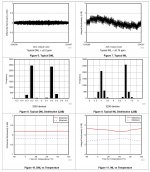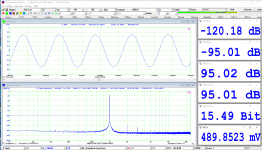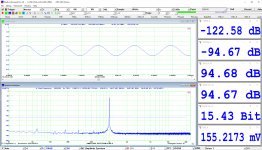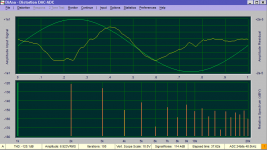Actually there are real considerations for the audio market that are different other that the elusive "sound". SNR or dynamic range in the audio band. A weights noise. THD which is related but not identical to DNL or INL. At the same time adding a lot of overhead to using an ADC (external interface logic, filtering etc.) would need justification if the primary requirements are not substantially better. SAR ADC's have a lot of interesting applications and the separation of the sampling rate from basic function can be really helpful in specific applications but audio will have very constant predictable sample rates etc. and the additional flexibility is not a benefit.
All audio grade ADCs, PCM4222, AK5572, CS5381, etc... have the (in my opinion) big issue of a sharp increase of the noise floor at high frequencies, making for example low distortion measurements @20KHz practically impossible. These noise humps root causes are well understood and very difficult to avoid in sigma-delta converters. I myself do not believe in the relevance of distortions @1KHz for the overall amplifier quality, so I consider audio measurements @20KHz critical.
Otherwise, I don't see in audio grade ADCs the DNL and INL (and in general any linearity metric) seriously characterized (other than a chart with a straight line), compare with the datasheet for a 20bit SAR (see attached). SNR and dynamic range in the audio band are related to the number of bits (and there are SARs up to 32bit, sacrificing the distortion performance for SNR and DR, but 20bit seems to be kind of sweet spot today).
Again, I don't preach any SAR for audio applications - but for audio instrumentation purposes they appears to me as a much better option than audio ADCs. Again, audio grade ADCs are simply not specified for instrumentation (and rightfully so, since this is not what they are designed for, as much as industrial grade SARs don't specify for example the A-weighted noise).
Attachments
Last edited:
All audio grade ADCs, PCM4222, AK5572, CS5381, etc... have the (in my opinion) big issue of a sharp increase of the noise floor at high frequencies, making for example low distortion measurements @20KHz practically impossible.
There is at least one exception, the AK5394A 🙂
The only measurement grade ADC in the audio portfolio was the AK5394A now discontinued. All the others trade audio band SNR for increasing noise out of band. I don't know DNL or INL have ever been characterized for the AK5394 (or any other audio part). it would be interesting. I'm not sure Virtins reported numbers are valid for ENOB etc. but they look serious.
There is at least one exception, the AK5394A 🙂
That could be the first and the last exception, for quite some time. But even this one, being limited to 216KHz sampling rate, is IMO not ideal for instrumentation. At 1Ms/sec (actually the LTC2378-20 works great even at 1.3Ms/sec), the modern 20bit SARs are beating it hands down.
I'm not sure Virtins reported numbers are valid for ENOB etc. but they look serious.
Not being a Virtins user, I did not know it can deliver this parameter. What is it showing for the AK5394 ENOB, at the maximum sampling rate?
I'll set up for that test later today. I thin I'll need to use an external oscillator so the DAC limitation is not there. And it would be at an audio frequency where the chip will deliver its best results. A current get SAR or even the newer delta sigma ADC's for industral application may do better. Very little new stuff has been done for audio ADC's in many years. Even AKM admits this whole line is a vanity project. None of these end up in cell phones where money is to be made. I got similar feedback from the guy managing the TI ADC and DAC biz. No volume or money in DAC's or ADC's over 100 dB SNR. Just not enough volume. ESS's success in cell phones is an outlier for now.
You can always use one of the faster ones like the LTC2387-18....
Or interleave multiple slower ones.... Or both 🙂 although that get expensive just for the parts.... And then decimate.
Or interleave multiple slower ones.... Or both 🙂 although that get expensive just for the parts.... And then decimate.
Here are a couple of plots using an external generator (AM70A) @ 1KHz. I'm not sure how to proplery interprest them or if the ENOB is valid. The generator is analog so it will have considerable phase noise compared to a digital source but much lower distortion. The distortion is all AK5394A + analog stuff. And, to be sure, this is not a truly optimum connection.
Attachments
Here are a couple of plots using an external generator (AM70A) @ 1KHz. I'm not sure how to proplery interprest them or if the ENOB is valid. The generator is analog so it will have considerable phase noise compared to a digital source but much lower distortion. The distortion is all AK5394A + analog stuff. And, to be sure, this is not a truly optimum connection.
15.4bit ENOB for a 24 bit ADC is rather low; I've posted earlier the ENOB for a 20 bit SAR (16.45 bit). I would think yours include a good chunk from the generator phase noise.
Last edited:
The generator is analog so it will have considerable phase noise compared to a digital source but much lower distortion.
The spread in the peak is due to the Kaiser-Bessel window, not (just) phase-noise.
Suggest for high dynamic range measurements you find a better window function with maximum sidelobes below -100dB.
Suggestions? Virtins has a lot of options. I don't know what to look for.
I don't know what options Virtins has, but I did find this paper that has nice descriptions of common functions and tradeoffs:
https://prod-ng.sandia.gov/techlib-noauth/access-control.cgi/2017/174042.pdf
Thanks. My head is spinning now. Maybe I'll reach a quantum state. . .
it left me a little more lost in some ways. Microwave bursts are a little different from audio but the discussions and plots are useful.
If time permits tomorrow I'll do a few tests with different sources.
it left me a little more lost in some ways. Microwave bursts are a little different from audio but the discussions and plots are useful.
If time permits tomorrow I'll do a few tests with different sources.
I would like to see how a 20-bit SAR performs with a jitter test signal. Perhaps that is a problem where you can see the "missing bits". Here an example measured with the RTX6001:
Here a measurement of the jitter test signal of Arta.
Green is a analog loopback of the analyzer in/out. This can be considered as no jitter reference as the ADC and DAC of the analyzer are clocked by the same clock.
Red is the DAM getting its signal from the analyzer via SPDIF.
You see there is next to no difference.
View attachment 733654
You need an extreme zoom to see deviations
View attachment 733655
Moreover this is the "differential jitter" between the DAM and the analyzer clock. So the "culpid" of the jitter could analyzer clock if the DAM is more stable.
What are the options? An awful lot of windows are good for only 60 to 90dB dynamic range. Good reading material about FFt windows in this paper: https://holometer.fnal.gov/GH_FFT.pdfSuggestions? Virtins has a lot of options. I don't know what to look for.
Suggestions? Virtins has a lot of options. I don't know what to look for.
How about choosing the DUT frequency such that it is periodic with respect to the FFT length and do it unwindowed.
How about choosing the DUT frequency such that it is periodic with respect to the FFT length and do it unwindowed.
It was an external signal generator, AM70A, for which I can't find much info, no idea if it can be synchonized.
edit: Ah, there's a current thread about it!
The AM70A generator section is part of an audio analyzer. Its oscillator runs open loop for frequency tuned in .5% steps with a lot of relays. I can try both a digital source and a more precisely tunable disciplined analog source but not for a few days.
Virtins Multi Instrument is available for trial download with full capability for those who have questions and wish to evaluate it. Don't even need a card or external converter to examine it.
Multi-Instrument, a powerful multi-function virtual instrument software - Virtins Technology
Multi-Instrument, a powerful multi-function virtual instrument software - Virtins Technology
- Home
- Design & Build
- Equipment & Tools
- ADCs and DACs for audio instrumentation applications



